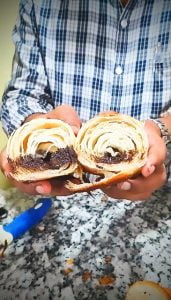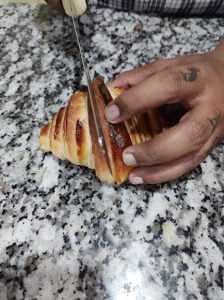The Perfect Croissant

There’s something mysterious — even alchemical — about the qualities that have to come together to yield the ideal croissant. It should be buttery and tender, but never mushy or overly moist. It requires a delicate flakiness-to-slight-chewiness ratio, and the layers of all-butter puff pastry should be well-differentiated, without falling apart into a crumby mess when you bite into them. The bake should be golden, but not overdone. In short, it’s an art — one that the French in particular are very proud of.
From the Austrian viennoiserie croissant version the French bakers added yeast to the puff pastry. This changed the texture and mouthfeel of the croissant significantly; yielding an airier, puffier, crispier specimen, which became flaky, buttery, with well-differentiated layers. During the nineteenth century, the croissant was essentially a luxury good reserved for the bourgeois and aristocratic classes; by the First World War it became more accessible and widely available.
Interestingly though, consumption habits fell along subtle class lines. We find many versions of the puff-pastry croissant, which emerged: one made with pure butter (croissant au beurre), and another, often made with margarine or other cheaper fats, called the croissant ordinaire (ordinary croissant). Some bakers call the latter a croissant nature (plain croissant). The croissant au chocolat: (a real croissant filled with chocolate and sometimes an icing-sugar coating). The croissant aux amandes: (almond croissant). The rich croissant aux chocolat et amandes: (almond and chocolate croissant). The savoury croissant jambon-fromage: (ham and cheese croissant).
There are a lot of bakeries in the city but finding a place for the best croissant is challenging. After quite a search I came across Prof. Rakesh aka Chef Rakesh, a teacher, mentor and founder of Chocolate Club, who has quite clear fundamentals on treating the dough and process for the best croissant. His crescents of the leavened dough are a joy. Especially his croissant au chocolat, which doesn’t even need to be popped into the oven or microwave for a whirl and are tasty even in the ambient temperature. This took me to my training days in the bakery section where only the most competent chefs were assigned the task of making croissants. Chef Rakesh’s dedication can be seen when he kneads the butter layer by layer and shapes the dough into those delectable familiar shapes.
His take: Making the perfect croissant has more to do with the science of baking than the skill of shaping and lamination. Selection of the right quality and grade of ingredients will have a major impact on the end product. Here is how he selects the perfect ingredients to make the perfect French Croissant. The flour has to be pure wheat flour (very high refined flour) with strength and baking quality slightly superior to ordinary bread flour (he gets the flour from North India — Delhi). Then the plasticity and stability to the croissant is established by using excellent quality of fats. Fats used for croissants must be butter or margarine having good plasticity and stability. The moisture content of the butter should be 15 per cent at most, and the point of fusion of margarine should not be higher than 36 degrees Celsius. Use of unsalted fat is recommended to get the right flavour.
For the bakers he suggests: Making croissants is a labour of love and dedication — “It’s just a few ingredients,” “but one needs skill to understand how everything works together.” According to him the humble French pastry is all about mastering time-intensive techniques to produce perfect results. Have patience, hone your skills with each subsequent batch one creates, and spot the difference between a good croissant and an exceptional one by understanding how the intricate pastry is constructed. Have the oven perfectly calibrated — 175 to 180 degrees Celsius with a good air circulation option. As the traditional recipe has been tweaked, with a familiar variant — the chocolate croissant that is swag and has an identity of its own – thus quality of chocolate has to be good and get it done in the last lamination and fold.
For the road
Croissants are a style of viennoiserie pastries, dating back to the Austrian city of Vienna, and otherwise known as the birthplace of croissants. The ancestor to the modern-day croissant was called the kipferl, which dates back to the 13th century and comes in various shapes and sizes, filled with nuts or other fillings, and kipferl (which has possible but unconfirmed roots in ancient Egypt), are also considered to be a form of rugelach, a Jewish pastry of Ashkenazic origin. They are denser and sweeter to what we think of as the modern croissant. Around the turn of the 17th century, that dough began to change, and the style of dough used in traditional croissants was first documented.
Legend has it, Viennese bakers working throughout the night heard the Turks as they tried to tunnel beneath the city during a 1683 invasion. They alerted the city’s defenders, in essence saving it from the Ottoman siege. In celebration, the bakers created a pastry that would symbolize the crescent moon, which is also the prominent symbol on the Turkish flag, when his fellow Austrians bit into the croissant, they would be symbolically devouring the Turks.
The story of how Austrian kipferl or Hörnchen arrived in France is another disputed one. For years, it was casually asserted that Queen Marie Antoinette, a native of Austria and daughter of the powerful Empress Maria Theresa, introduced it to the court at Versailles in 1770 after her marriage to King Louis XVI. Marie Antoinette popularized the croissant in France by requesting the royal bakers replicate her favourite treat from her homeland, Austria.
But it was August Zang, an Austrian artillery officer who founded a Viennese Bakery in Paris in around 1839. This bakery served Viennese specialties including the kipferl (croissant) and the Vienna loaf, which became very popular and inspired French bakers. The dough became lighter and more delicate through time, and the kipferl was developed into what is known now as the croissant. Zang’s Parisian version, though, was made flakier than the traditional sweets, and Parisians began calling them croissants because of their crescent shapes. Finally, in 1915, a French baker named Sylvain Claudius Goy wrote the recipe. It found its legitimacy in the Larousse Gastronomique (1938, first edition). The croissant, of course, resides in more amicable circumstances today. It has travelled the world over and has many variants from world over.



Comments are closed.